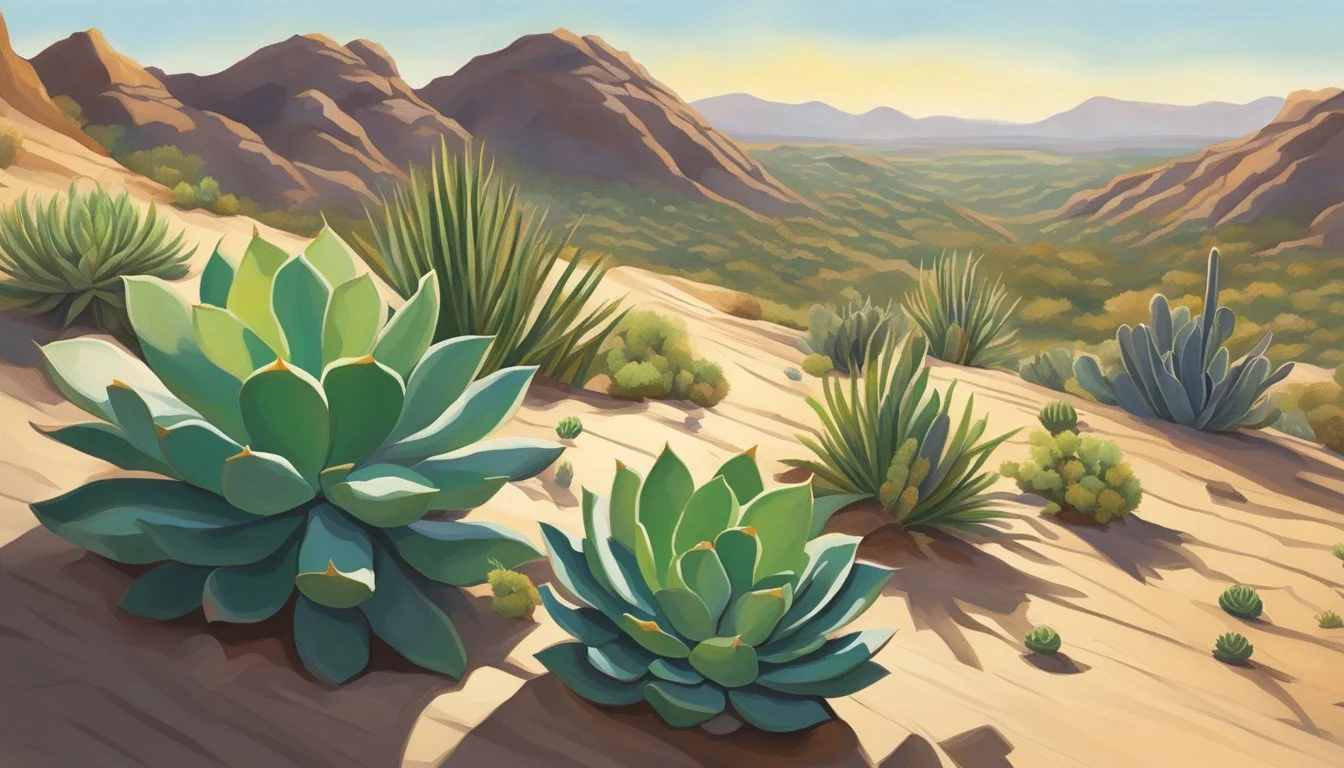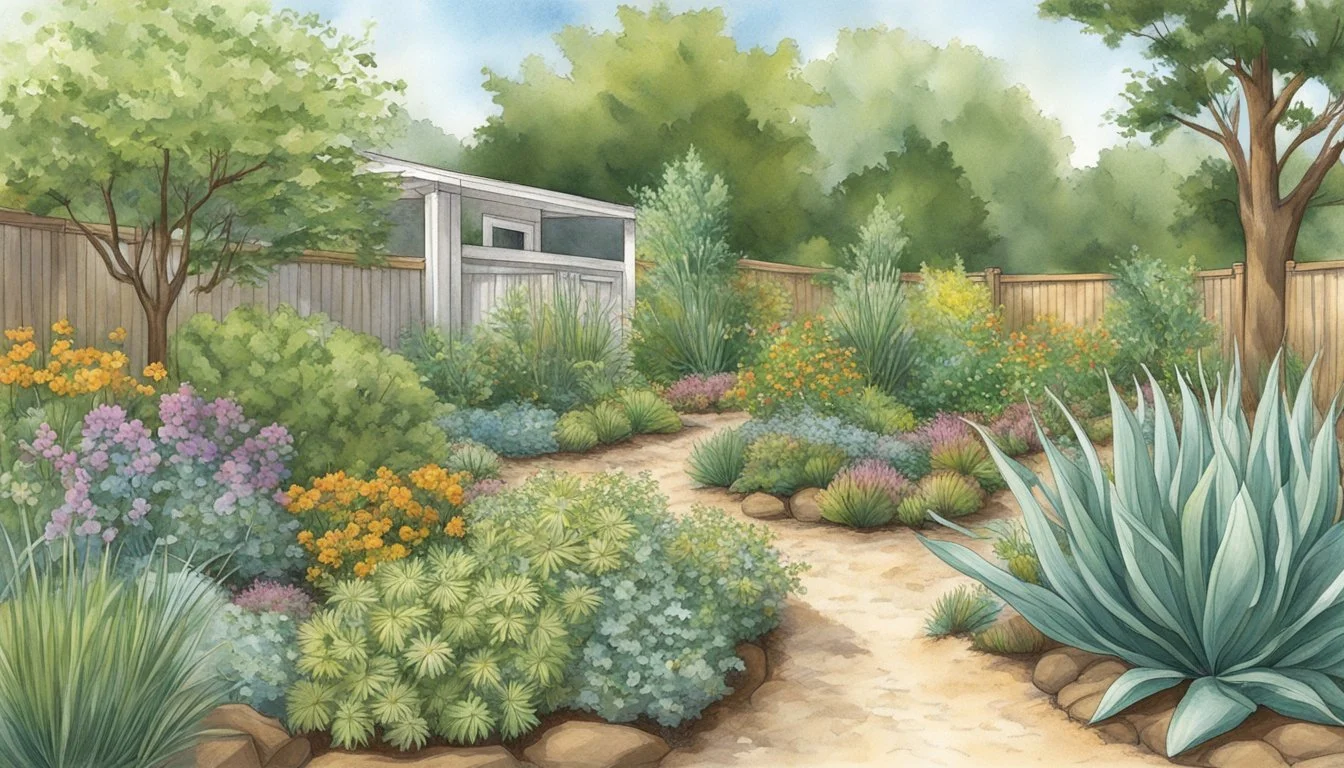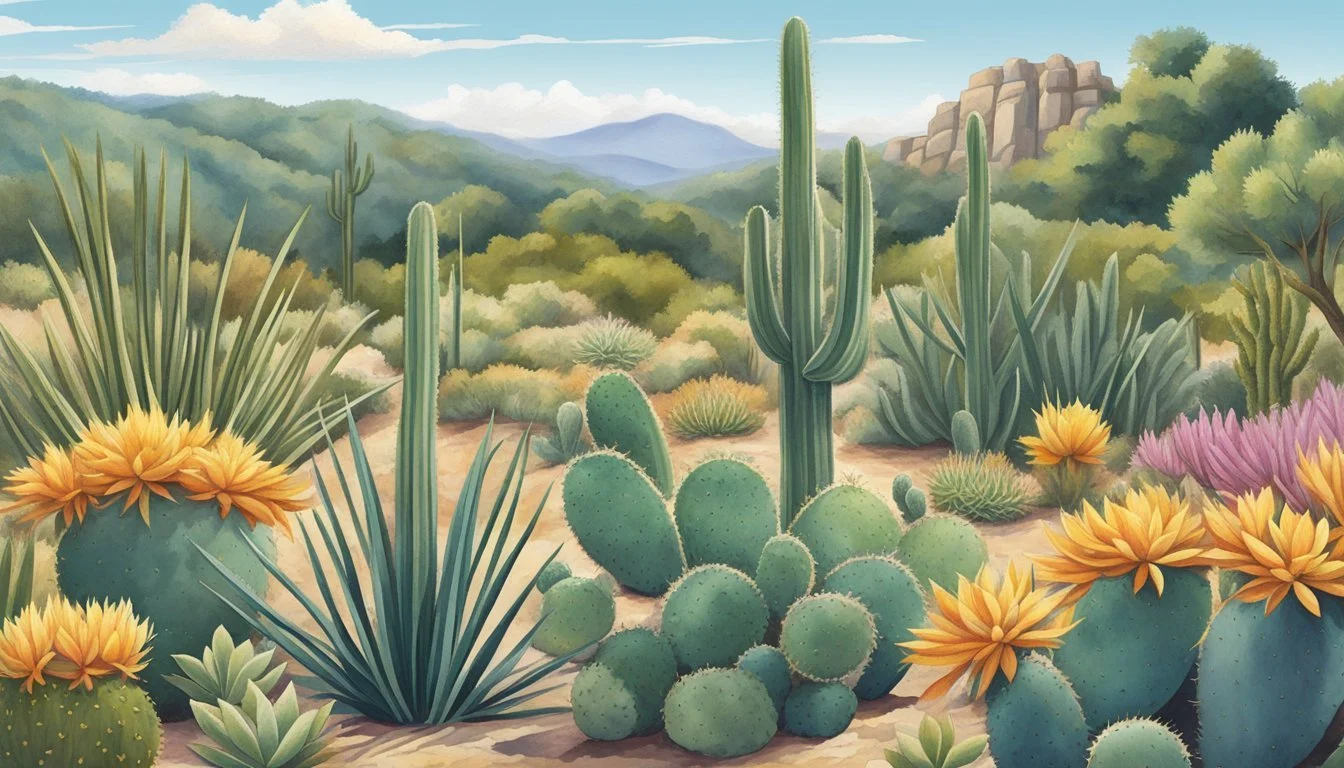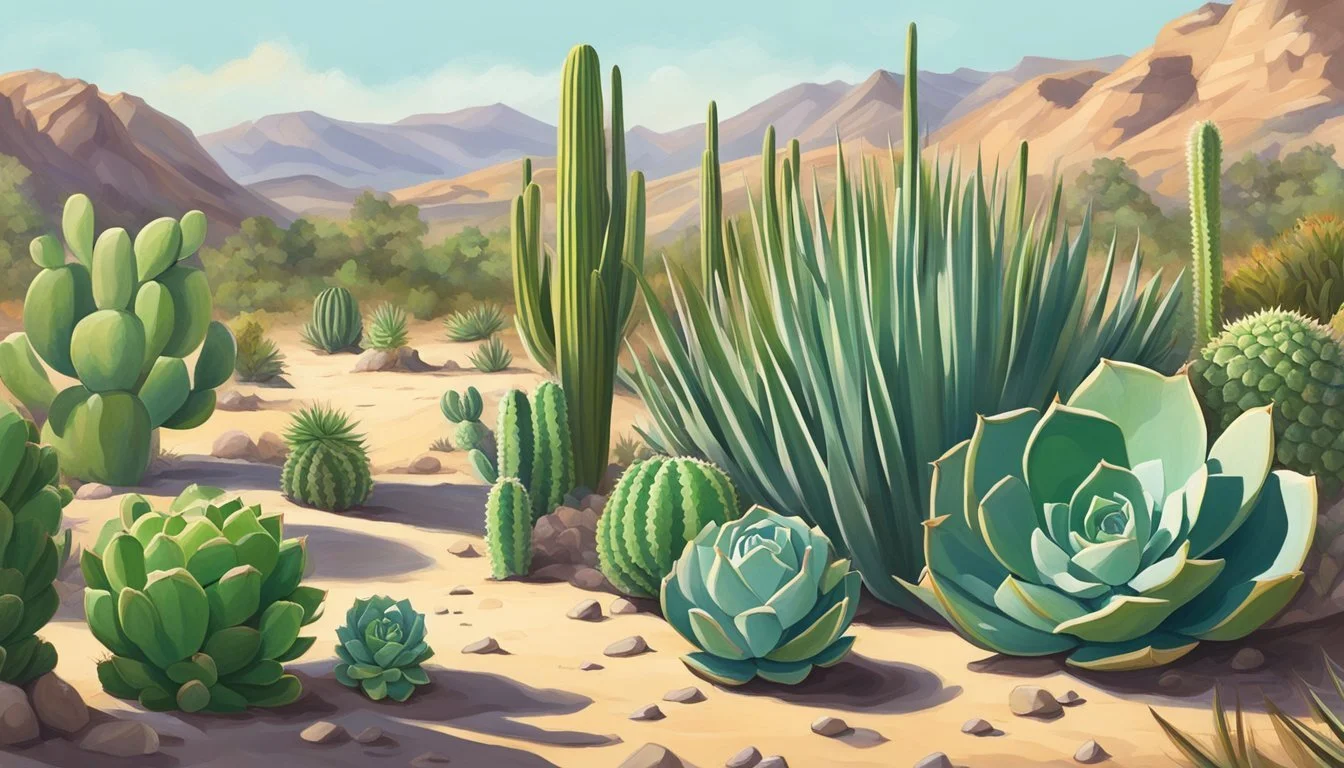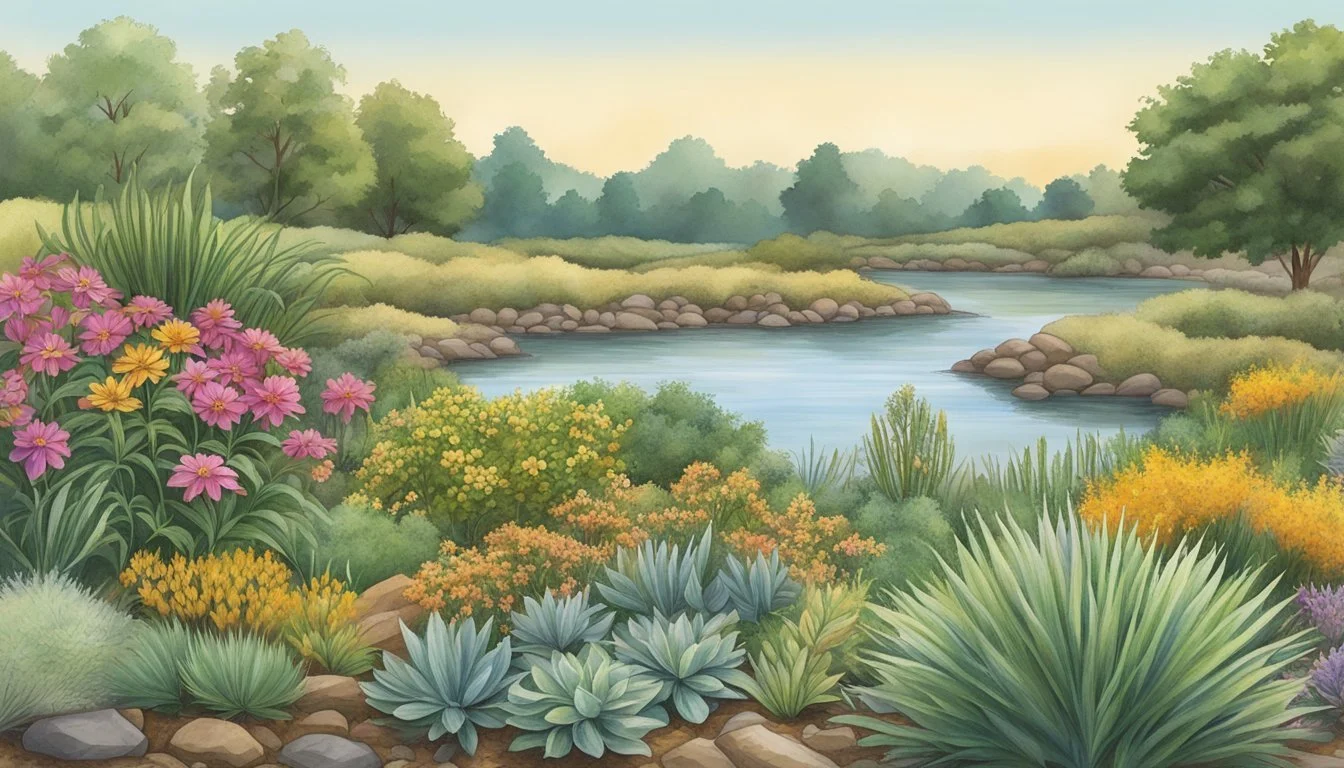Drought-Tolerant Plants in North Carolina
A Guide to Resilient Landscaping
Drought-tolerant plants have become increasingly significant in North Carolina due to the state's susceptibility to periodic droughts. These resilient plant species are adapted to survive in arid conditions by efficiently using water and resisting the stress caused by scarcity. In North Carolina, gardeners and landscapers are turning toward these hardy varieties as a sustainable solution to maintain verdure without imposing heavy demands on water resources.
Selecting the right drought-tolerant plants can provide a robust, low-maintenance garden that conserves water and thrives in varying climatic conditions. North Carolina's varied geography, from the Appalachian Mountains to the Coastal Plain, offers a diverse palette of native flora that are innately equipped to handle the regional climate's challenges. By incorporating these plants into their landscapes, residents can enjoy bursts of color and lush gardens even during dry spells.
Understanding Drought and Its Impact on Flora
Drought severely constrains the vitality of plant life within affected regions. Understanding its nature and effects provides essential insights for adapting to and mitigating its impacts on ecosystems and agriculture in North Carolina.
Defining Drought Conditions
Drought is characterized by a prolonged period of deficient rainfall, leading to a dry climate that adversely affects water availability. Environmental conditions across the US, including North Carolina, have been marked by varying degrees of drought, defined by meteorological (lack of precipitation) and hydrological (low water in streams and reservoirs) criteria. These conditions are gauged over a spectrum, from "abnormally dry" to "exceptional drought," based on the intensity and duration of water scarcity.
Effects on Ecosystems and Agriculture
Drought's impact on flora is profound, ranging from stunted growth to increased mortality rates. In ecosystems, drought can lead to shifts in species composition and decreased biodiversity, as plants struggle to survive the dry conditions. Agricultural areas are particularly vulnerable; decreased water supplies can lead to reduced crop yields and soil degradation, which in turn threaten food security and livelihoods. Climate variability has the potential to exacerbate these issues, underscoring the need for drought-tolerant plant cultivation as a proactive measure.
Drought-Tolerant Plant Characteristics
In North Carolina, drought-tolerant plants exhibit specialized adaptations allowing them to thrive in water-scarce environments. These characteristics enable them to conserve water effectively and establish themselves in soils that may challenge less adapted species.
Adaptations for Water Conservation
Drought-tolerant plants, such as yellow jessamine (Gelsemium sempervirens), possess traits that help conserve water even under prolonged dry conditions. For instance, their leaves often exhibit a waxy or leathery texture, reducing water loss through evaporation. These adaptations make them particularly resilient to heat and sunlight.
Leaf Structure: Reduced leaf size to minimize water loss and sometimes covered in fine hairs, reflecting light away to keep the leaf surface cool.
Stomatal Control: Advanced stomatal regulation allows for greater control over water transpiration, with some species only opening their stomata during cooler parts of the day.
Soil Preferences and Root Systems
The root systems of drought-tolerant plants like baptisia, with its deep taproot, are designed to access moisture from deep within the soil. These plants tend to favor well-drained, sandy or rocky soils, allowing their roots to penetrate deeply and avoid waterlogged conditions which can lead to rot.
Deep Roots: Taproots that reach deep into the soil to access lower moisture levels.
Soil Type: Predilection for sandy soils which require plants to have more aggressive water-seeking root systems.
These particularities assure that even in the toughest soils and driest climates, drought-tolerant flora can not only survive but also flourish.
Selecting the Right Plants for Your Garden
When creating a drought-tolerant garden in North Carolina, choosing the right plants is paramount for sustainability and garden success. This selection process involves understanding the differences between annuals and perennials, the advantages of native plant species, and assessing the particular sunlight and space requirements of your garden location.
Annuals Vs. Perennials in Drought
Annuals, such as marigolds and zinnias, complete their life cycle in one growing season, offering vibrant color from spring to fall. They often require less commitment but may need more water and care to thrive during dry periods. In contrast, perennials are known to withstand drought better due to deeper root systems that access water at lower soil levels. Plants like beardtongue (Penstemon spp.) are renowned for their resilience and ability to return yearly with minimal maintenance.
Native Plants and Their Benefits
Incorporating native plants into the North Carolina garden capitalizes on species already adapted to the local climate and soil conditions. These plants typically require less water and care than non-natives. For example, the American beautyberry is not only drought-resilient but also provides stunning visual interest across seasons, with the added benefit of supporting local wildlife.
Assessing Sunlight and Space Requirements
Understanding the sunlight and space available in your garden is crucial. Drought-tolerant plants have varied requirements:
Full sun: Most drought-tolerant species, such as lavender and Russian sage, thrive with six or more hours of direct sunlight daily.
Space and size: It's important to consider the mature height and size of plants. Some, like ornamental grasses, can grow several feet tall and just as wide, making them unsuitable for small or crowded gardens.
By carefully evaluating your garden's light exposure and spatial dimensions, one can ensure proper plant growth and minimize the need for supplemental water or pruning.
Cultivating a Drought-Resilient Garden
Crafting a garden that thrives during dry conditions involves selecting the right plants and employing effective gardening techniques. This section provides specific strategies for developing a garden that conserves water and withstands periods of drought.
Basic Gardening Techniques
Choosing drought-tolerant plants is the first step in crafting a resilient garden. Native species like the Piedmont plant varieties excel in local conditions and require less water. Proper plant spacing is also critical; it allows for ample airflow, reduces disease risk, and minimizes watering needs by reducing competition for water resources.
Select Plants Wisely: Opt for natives that handle dry spells.
Space Appropriately: Allow for air circulation and reduced competition for water.
Soil Amendments and Fertilization
Amending the soil with organic material improves water retention and drainage, effectively supporting plant health during parched summers. A generous layer of mulch can keep the soil temperature consistent, aiding in moisture conservation. When it comes to fertilization, less is more in a drought-prone garden. Excessive fertilizer can promote lush growth that demands more water, so one should use fertilizer sparingly and select formulations that match the specific needs of the plants in the garden.
Modify Soil: Integrate organic matter to enhance water retention.
Mulch: Apply a layer to regulate soil temperature and retain moisture.
Fertilize Wisely: Utilize only what is necessary to prevent excessive growth.
Maintaining Plants During Drought
Regular maintenance is key to ensuring a garden remains vibrant, even in periods of scant rainfall. Efficient watering practices, such as the use of drip irrigation or soaker hoses, target the root zone directly, minimizing water waste. One can also reduce watering frequency by allowing plants to build deeper root systems that are more drought-resistant. Monitoring the garden for signs of stress and adjusting care accordingly will help plants better survive the harsh conditions of a drought.
Water Efficiently: Focus on the root zone to avoid wastage.
Encourage Deep Roots: Water less frequently to promote resilience.
Observe and Adjust: Look for stress indicators and adapt care practices.
Popular Drought-Tolerant Plants in North Carolina
North Carolina's varying climate requires landscaping with resilience in mind. The following drought-tolerant plants are well-suited for the state's soil and weather conditions, offering beauty and dependability.
Trees and Shrubs
Trees and shrubs form the backbone of any garden, and several species thrive in North Carolina's drought-prone environment. Virginia Sweetspire (Itea virginica) is a versatile shrub with fragrant white flowers, offering a stunning display and resilience against dry spells. Meanwhile, Baptisia, known as Wild Indigo, stands out with its blue to white blossoms, adding both color and durability to local landscapes.
Virginia Sweetspire: Fragrant white blooms, attracts pollinators.
Baptisia: Features blue to white flowers; hardy and drought-resistant.
Perennials and Groundcovers
Perennials and groundcovers are exceptional for their ability to withstand dry periods while still providing vibrant colors and textures to gardens. Coneflowers like the Echinacea purpurea (Purple Coneflower) are not only striking with their purple-petaled flowers but are also known for their medicinal properties. Asclepias tuberosa, commonly called Butterfly Milkweed, delights with its orange blooms and serves as an important nectar source for monarch butterflies. In addition, Liatris, Phlox, Salvia, Sedum, Coreopsis, Gaillardia, and Goldenrod stand out as drought-tolerant perennials that can bring continuous life and color to gardens even in the driest conditions.
Echinacea purpurea (Purple Coneflower): Purple flowers, attracts wildlife, offers medicinal uses.
Asclepias tuberosa (Butterfly Milkweed): Bright orange flowers, essential for monarch butterflies.
Liatris & Phlox: Provide a spectrum of colors and attract pollinators.
Salvia & Sedum: Offer unique textures and are highly adaptable to dry environments.
Coreopsis & Gaillardia: Display vibrant, sun-loving blooms.
Goldenrod: Known for its tall, waving sprays of yellow flowers.
These plants are not just aesthetically pleasing but are also practical choices for maintaining a beautiful and sustainable garden in North Carolina's challenging climate.
Plant Profiles: Favorites Among Gardeners
In North Carolina, gardening enthusiasts often turn to native and adaptable flora that promise both beauty and resilience during dry spells. Here are some select plants that not only withstand drought conditions but also appeal to a variety of pollinators.
Native Flowers and Grasses
Daylilies (Hemerocallis spp.) stand out with their vibrant, trumpet-shaped blooms, each flower lasting for just a day. They offer a range of colors and are particularly attractive to butterflies. For textured green foliage and an upright habit, Switchgrass (Panicum virgatum) is a stalwart, with panicles that can catch the light enchantingly.
On the shorter side, Little Bluestem (Schizachyrium scoparium) adds interest with blues in summer and rich, coppery tones come fall. Butterfly weed (Asclepias tuberosa) serves as a crucial host for monarch butterflies with its bright orange flowers, while Salvia farinacea, known for its dense spikes of deep blue flowers, is a magnet for bees and butterflies alike.
Daylily
Season of Interest: Summer to Fall
Benefits: Diverse colors, attracts pollinators
Switchgrass
Season of Interest: Summer to Winter
Benefits: Showy seed heads, food for birds
Little Bluestem
Season of Interest: Fall to Winter
Benefits: Winter interest, erosion control
Butterfly Weed
Season of Interest: Summer
Benefits: Attracts butterflies, medicinal
Salvia farinacea
Season of Interest: Summer to Fall
Benefits: Attracts pollinators, low maintenance
Drought Tolerant Flowers and Grasses Season of Interest Benefits Daylily Summer to Fall Diverse colors, attracts pollinators Switchgrass Summer to Winter Showy seed heads, food for birds Little Bluestem Fall to Winter Winter interest, erosion control Butterfly Weed Summer Attracts butterflies, medicinal Salvia farinacea Summer to Fall Attracts pollinators, low maintenance
Deciduous Trees and Evergreens
Among trees, the Red Maple (Acer rubrum) displays stunning bright red foliage in the fall, while the Persimmon (Diospyros virginiana) bears fruit that attracts wildlife. Sourwood (Oxydendrum arboreum) offers year-round interest with spring flowers, summer greenery, and vivid autumn leaves.
Evergreens such as the American Holly (Ilex opaca) and Eastern Red Cedar (Juniperus virginiana) provide constant greenery even during the coldest months. Wax Myrtle (Morella cerifera) and Winterberry (Ilex verticillata) attract birds with their berries, and the bold texture of Yaupon Holly (Ilex vomitoria) is a year-round delight.
Deciduous Trees:
Diospyros virginiana (Persimmon): Produces fruit, fall color
Oxydendrum arboreum (Sourwood): Fragrant flowers, fiery fall foliage
Acer rubrum (Red Maple): Brilliant fall color, adaptable
Evergreens:
Ilex opaca (American Holly): Bright red berries, good for wildlife
Juniperus virginiana (Red Cedar): Hardy, provides winter interest
Morella cerifera (Wax Myrtle): Fragrant foliage, great for screening
Ilex verticillata (Winterberry): Decorative berries, attracts birds
Wildlife Attraction and Support
Selecting the right plants for a North Carolina garden can support local wildlife by attracting various pollinators and providing critical habitats. Using native plant species is conducive to creating a sustainable and vibrant ecosystem.
Attracting Pollinators With Native Species
Native plants are inherently adapted to the local climate and soil conditions of North Carolina, making them more likely to thrive with less need for supplemental watering or fertilizers. These plants often provide the best nectar sources for local pollinators including bees and butterflies. For instance, the North Carolina Botanical Garden recommends various drought-tolerant native plants that serve as robust nectar hubs for pollinators.
Creating Habitats for Butterflies and Bees
Butterfly populations, such as the monarch butterfly, rely on specific native plants during their larval stage. Monarch caterpillars, for instance, need milkweed to grow and develop into butterflies. By incorporating plants like milkweed into their gardens, North Carolina residents can offer crucial support for these migratory butterflies. Similarly, by planting native species like those listed by the North Carolina Native Plant Society, gardeners can provide bees with a stable habitat and ample flowering plants from which they can collect pollen, ensuring a diverse and healthy environment.
Practical Landscaping Tips
When creating drought-resistant landscapes in North Carolina, a homeowner should consider both aesthetics and utility. Thoughtful design paired with strategic mulching and watering can yield a garden that conserves water while maintaining its allure.
Designing With Aesthetic and Function
In landscaping, one should aim for a balance between visual appeal and sustainability. Native plants such as the New Jersey-tea are excellent choices for a functional yet attractive garden as they require less water and are adapted to local conditions. Grouping plants with similar watering needs together, known as hydrozoning, streamlines watering processes and increases efficiency. Incorporating rock features or dry riverbeds can also add interest to the area while reducing the need for water-sensitive plants.
Mulching and Watering Strategies
Mulching is a crucial practice for water conservation in any landscape. A layer of mulch helps retain soil moisture, thus decreasing the need for frequent watering. Homeowners should apply about a 4-inch layer of organic mulch around plants, ensuring that it's not too close to the stems to prevent rot. Additionally, the use of drought-tolerant plants aids in reducing the landscape's overall water consumption. For watering strategies, implementing drip irrigation or soaker hoses targets the plant roots more directly than overhead watering, which can lead to evaporation and wasted water. Watering during the cooler parts of the day, such as early morning or evening, further reduces evaporation and makes each watering session more effective.
Seasonal Care and Management
In North Carolina, ensuring the longevity and health of drought-tolerant plants involves specific seasonal care and management techniques. These practices maximize plant resilience and enhance garden vitality throughout the year.
Spring Preparation
Spring heralds a time for garden rejuvenation. During this season, maintenance activities such as mulching and watering are vital. Gardeners should:
Inspect plants for winter damage and prune as necessary.
Apply a fresh layer of mulch to conserve moisture and suppress weeds.
Summer Upkeep
Summer demands attention to hydration and soil conservation. Despite drought tolerance, plants still need care during intense heat:
Water deeply and less frequently to encourage strong root development.
Monitor plants for signs of stress and provide shade if necessary.
Fall Planning and Planting
Fall is the optimal time for planting new drought-tolerant species and for planning future garden structure. Gardeners can take advantage of the moderate temperatures by:
Planting new additions to the garden to establish roots before winter.
Assessing and amending soil to improve its quality for the upcoming seasons.
Winter Protection Measures
Winter's chill requires protective measures to safeguard plants against frost. Protective steps taken in the fall often ensure plant survival:
Mulching to insulate roots from temperature fluctuations.
Sheltering sensitive plants with burlap or frost cloth when freezing temperatures are forecasted.
Cultural and Environmental Significance
In North Carolina, drought-tolerant plants are more than a practical response to water scarcity; they embody a cultural heritage and offer vital environmental benefits. By integrating these species into landscaping, the state preserves its ecological history and supports sustainable living.
Drought-Tolerant Plants in Local Culture
Drought-tolerant plants have been woven into the fabric of North Carolina's culture, symbolizing the resiliency and adaptability of its people. Historically, species like the flowering dogwood have not only thrived under the pressures of a changing environment but also hold a special place in local traditions, serving as emblems for the state and witnessing the passage of seasons in gardens and public spaces.
Contributions to Biodiversity and Sustainability
Native, drought-tolerant species play a crucial role in maintaining biodiversity in North Carolina. These plants provide essential habitats and food sources for local wildlife, creating ecosystems that contribute to the health of the environment. In terms of sustainability, utilizing plants like black-eyed Susan and others ensures that gardens demand less water, reducing the human impact on water reserves and promoting a balance between human needs and those of the natural world.
Ensuring Plant Health and Longevity
Proper care and maintenance are fundamental for ensuring the health and longevity of drought-tolerant plants in North Carolina. Specific attention to combating common diseases and pests, along with maintaining nutritious soil conditions, is vital to cultivating a thriving garden.
Common Diseases and Pests
Drought-tolerant plants commonly face threats from fungal pathogens and insect pests, which can significantly impact their health. Powdery mildew and root rot are frequent fungal diseases that afflict plants when air circulation is poor or when there is excessive soil moisture. Pests such as the aphid and spider mite can cause extensive damage to plants by sucking sap and reducing plant vigor. Timely identification and treatment using fungicides or pest-specific insecticides are crucial steps in ensuring plant resilience.
Fungal Diseases:
Powdery mildew: white, powdery fungus on leaves
Root rot: decay of root system, often due to overwatering
Insect Pests:
Aphids: small, sap-sucking insects harming plant growth
Spider mites: tiny spiders causing yellowing and stippling on leaves
Soil Health and Plant Nutrition
Optimizing soil health is a cornerstone for plant longevity and directly influences nutrient uptake. Balancing soil pH and integrating organic matter such as compost improves soil structure and fosters beneficial microbial activity. Adequate levels of key nutrients, including nitrogen, phosphorus, and potassium, support plant growth and resilience against environmental stressors.
Soil Composition: Ensure good drainage and adequate aeration
Nutrient Management: Regularly test and amend soil based on nutrient deficiencies
Ensuring the use of well-adapted plant varieties and implementing best practices for soil and pest management are the surest ways to maintain the longevity and health of drought-tolerant plants in a garden.
Resources and References
For individuals interested in cultivating drought-tolerant plants in North Carolina, several specific resources and references are invaluable. These include local establishments and online platforms that offer expert advice, native plant information, and community support.
Local Nurseries and Plant Societies
Local nurseries offer a hands-on selection of native plants that are ideal for North Carolina's climate and can withstand dry conditions. Plant societies often have experienced gardeners and horticulturists who provide insights into drought-tolerant species and practical planting techniques. Examples include:
North Carolina Botanical Garden: Their list of recommended drought-tolerant plants is particularly useful for the Piedmont region.
North Carolina Native Plant Society: This organization promotes the conservation of native flora and offers a guide on recommended native species, including those that are drought-resistant.
Online Guides and Gardening Communities
Online resources provide extensive information on plant care, drought management, and community forums for sharing knowledge and experiences. Notable online guides for gardeners in North Carolina include:
NC State Extension, Gardening: Their native plant resources feature various databases and guides for selecting plants suitable for different environments.
Pond Informer: A comprehensive resource detailing 20 drought-tolerant plants for North Carolina gardens, complete with vivid imagery and botanical names.
Gardening communities online can also provide support through discussion boards and social media groups where gardeners exchange tips on maintaining drought-tolerant gardens.
Frequently Asked Questions
When selecting plants for a drought-prone region like North Carolina, understanding which varieties are suited to such conditions is vital. Knowledge of native species, sun tolerance, and low-maintenance options can guide gardeners to make informed choices.
What are some drought-tolerant shrubs native to North Carolina?
Native shrubs such as the Oakleaf Hydrangea and Wax Myrtle have evolved to thrive in North Carolina's climate. These shrubs can withstand dry periods once established, providing resilience in a drought-tolerant landscape.
Can you list low-maintenance plants that are drought-resistant in North Carolina?
Yarrow and Coreopsis are low-maintenance perennials that are drought-resistant. Their adaptability to North Carolina's climate conditions makes them excellent choices for gardeners seeking minimal upkeep.
Which plants are suitable for full sun in North Carolina and are drought-tolerant?
For areas with full sun exposure, plants like Eastern Purple Coneflower and Black-eyed Susan are ideal. They not only tolerate drought conditions but also thrive in the heat and bright sunlight of North Carolina summers.
What are the best options for drought-tolerant landscaping plants in North Carolina?
Landscapers often recommend the use of ornamental grasses such as Pink Muhly Grass or plants like the Butterfly Weed, which are well-suited to North Carolina's environment and can tolerate dry spells.
Could you recommend drought-tolerant plants for container gardening in North Carolina?
Sedum and Lavender are excellent for container gardening. They require little watering and can thrive in the confined spaces of containers, making them practical for patios and balconies.
Are there any evergreen plants that are particularly good at tolerating drought in North Carolina?
The Southern Magnolia and Eastern Red Cedar are evergreens known for their drought tolerance. They retain their foliage throughout the year and can withstand the dry conditions often encountered in North Carolina.

